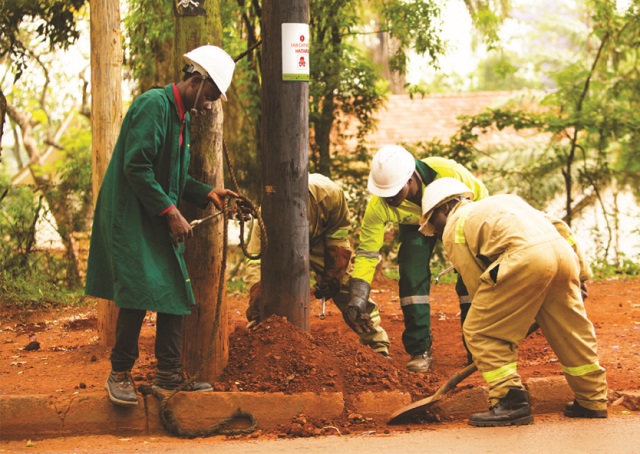
Company expects more revenue from government’s free connection policy
Kampala, Uganda | JULIUS BUSINGE | Power distributor, Umeme Limited recorded a 70% jump in profit after tax for the year ended December 2018 compared to the previous year.
This came after the company settling a conflict regarding a specific clause in its contract that suppressed revenue in the year 2017.
Based on the original contract, Umeme had been allowed to earn some extra revenue accruing from extra power sold beyond the target set by the regulator, a clause that show the company record Shs115bn as revenue by close of financial year 2016.
However, in the period before 2016, Electricity Regulatory Authority amended the license and in the process Umeme had to forego Shs115bn which it recorded as expenses in its financial books for the year 2017 – leading to a decline in profits.
However, in 2018, the company bounced back to its normal performance, recording a Shs132bn as net profit, up from Shs35.4bn in 2017. The cost of sales reduced from Shs960bn to Shs912bn.
But repair and maintenance costs increased from Shs37bn to Shs45bn. Administrative expenses grew from Shs161 to Shs179bn, leading to an increase in general operating costs of the business from Shs199bn to Shs226 billion during the same period under review.
Officials said prolonged rainy season in the year increased expenditure on network repairs and maintenance to ensure public safety and supply reliability.
Total assets increased from Shs2.3billion in 2017 to Shs2.4billion in 2018. Shareholder equity increased from Shs618billion in 2017 to Shs722 billion in 2018. The increase is attributed to profits for the year.
The company also reported that net cash flows generated from operating activities increased by 31% to Shs395billion. The funds were used to fund investments in the network and financing commitments of the business. Customers connected to the grid, within the Umeme footprint, increased by 14.8% to 1.3 million.
“We acknowledge the need to accelerate the connections rate under the government’s electricity connections policy to achieve the national development plans,” officials said in the financial statement.
The energy losses for 2018 were 16.6% compared to 17.2% for 2017. Over this regulatory cycle, energy losses have reduced by 10.7%.
Selestino Babungi, the company’s managing director told journalists at Protea Hotel on March 25 that through the introduction of prepaid metering, improvements in quality of service and open platforms for electricity bills payments, the company achieved an average revenue collection rate of 99% over the seven year cycle.
This development comes as the company is still in negotiation with the government to extend its concession that expires in 2025.
On a positive note, the operating cost per customer in the year 2018 was Shs174, 665 compared to Shs177, 092 in 2017 due to the use of technology, roll-out of pre-paid metering, increase in customer connections and efficiency in business operations.
Babungi said the company remained resilient in 2018 and focused on the path forward to deliver and to satisfy customers’ needs, meet the expectations of stakeholders, while achieving sustainable returns to shareholders.
The directors recommended a final dividend of Shs 28.2 per ordinary share to be paid for the year ended December 2018, up from Shs7.6 paid in 2017.
Meanwhile, during the year, electricity sales increased by 9.1% to 3,011 GWh from the 2017 out-turn of 2,760 GWh. The industrial segment recorded an average growth of 12% in 2018.
Going forward, Babungi expects an upward trend in demand for electricity that should translate into more sales by Umeme and its growth.
“Umeme continues to focus on improving efficiencies that benefit our customers in the form of reducing energy losses, increasing revenue collections and reducing operating costs,” he said.
He said Umeme’s investment in the network is in line with Uganda’s increase in installed generation capacity projected at 1,167 MW once Karuma HPP Dam (600 MW) is commissioned at the end of this year.
In addition, he said that investments will support efforts by government to implement the 2018 electricity connections policy, aimed at accelerating grid connections, through subsidisation of the last mile capital costs. The government aims to add at least 300,000 consumers to the grid every year through this policy.
The company also invested Shs231 billion in the distribution network relating to load growth and grid expansion projects.
****
 The Independent Uganda: You get the Truth we Pay the Price
The Independent Uganda: You get the Truth we Pay the Price




“He said Umeme’s investment in the network is in line with Uganda’s increase in installed generation capacity projected at 1,167 MW once Karuma HPP Dam (600 MW) is commissioned at the end of this year.”
Already Uganda’s generation capacity as of April 2019 is at 1167mw and when 600mw karuma is commissioned by the end of 2019 capacity will rise to above 1700mw.